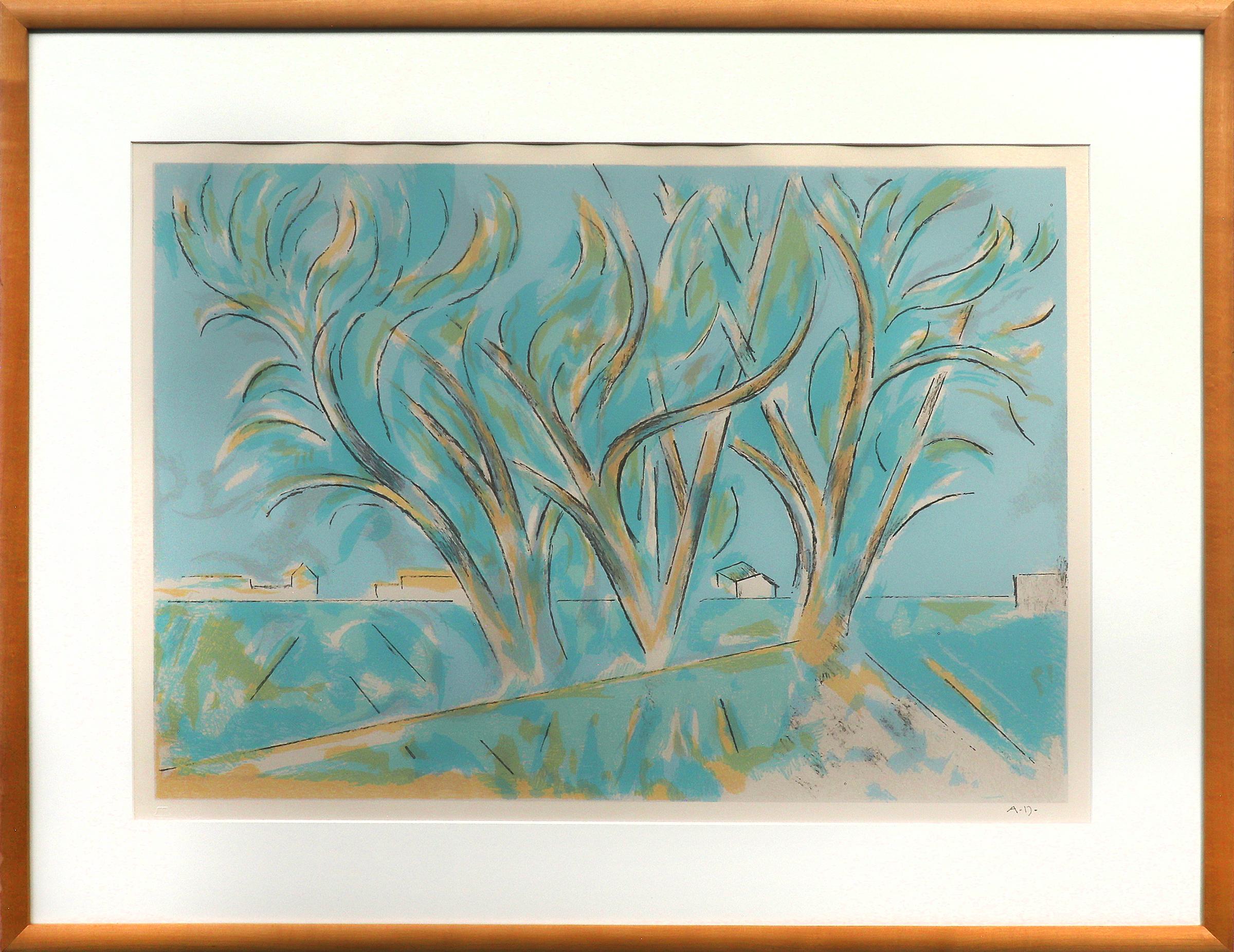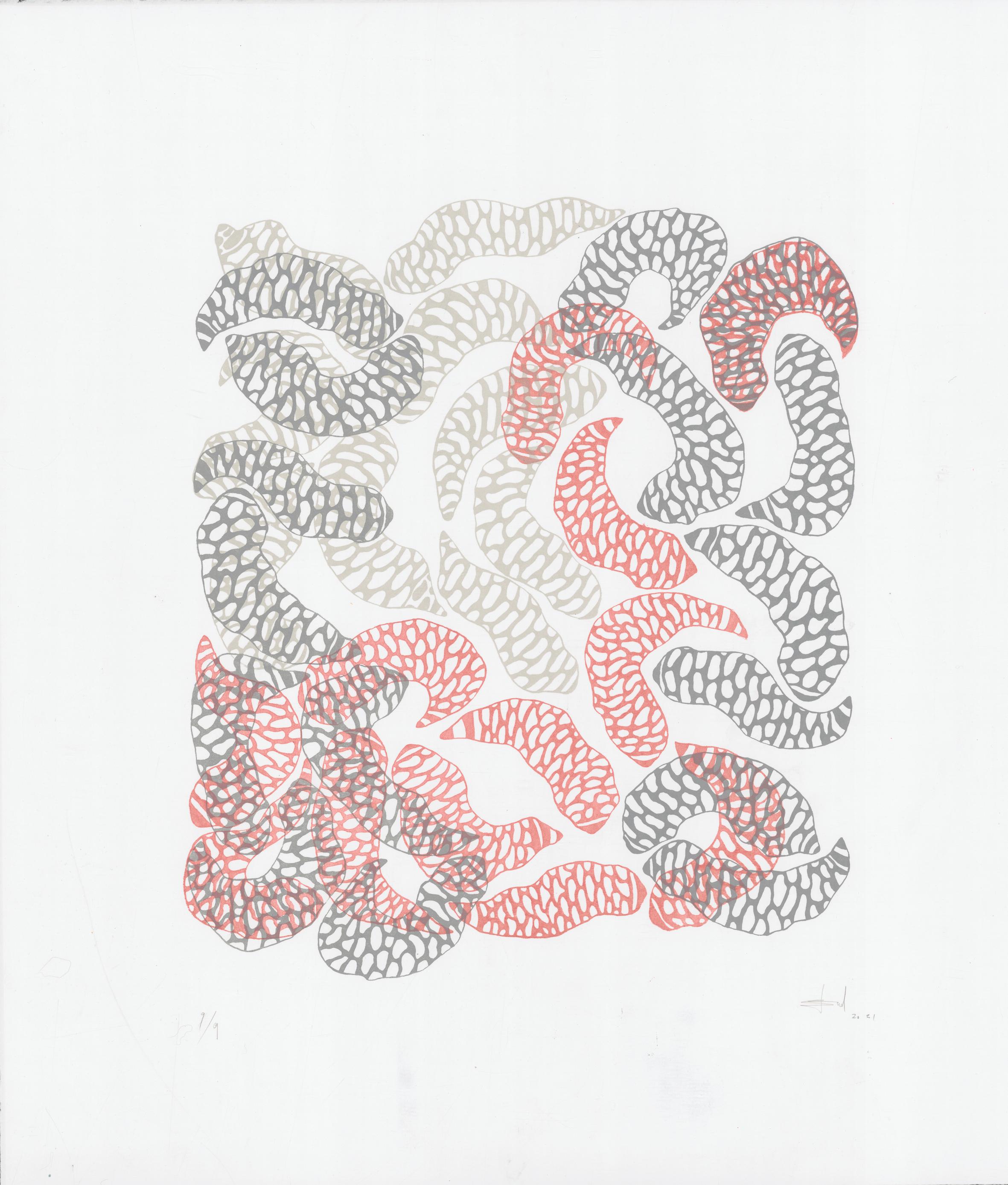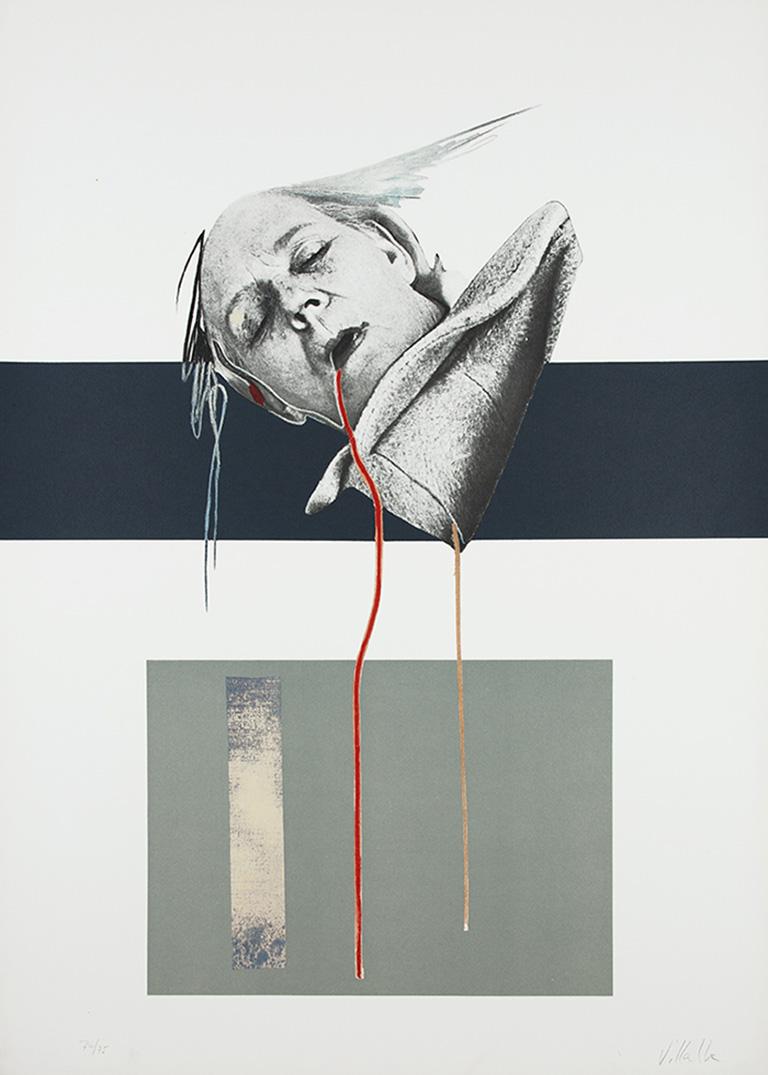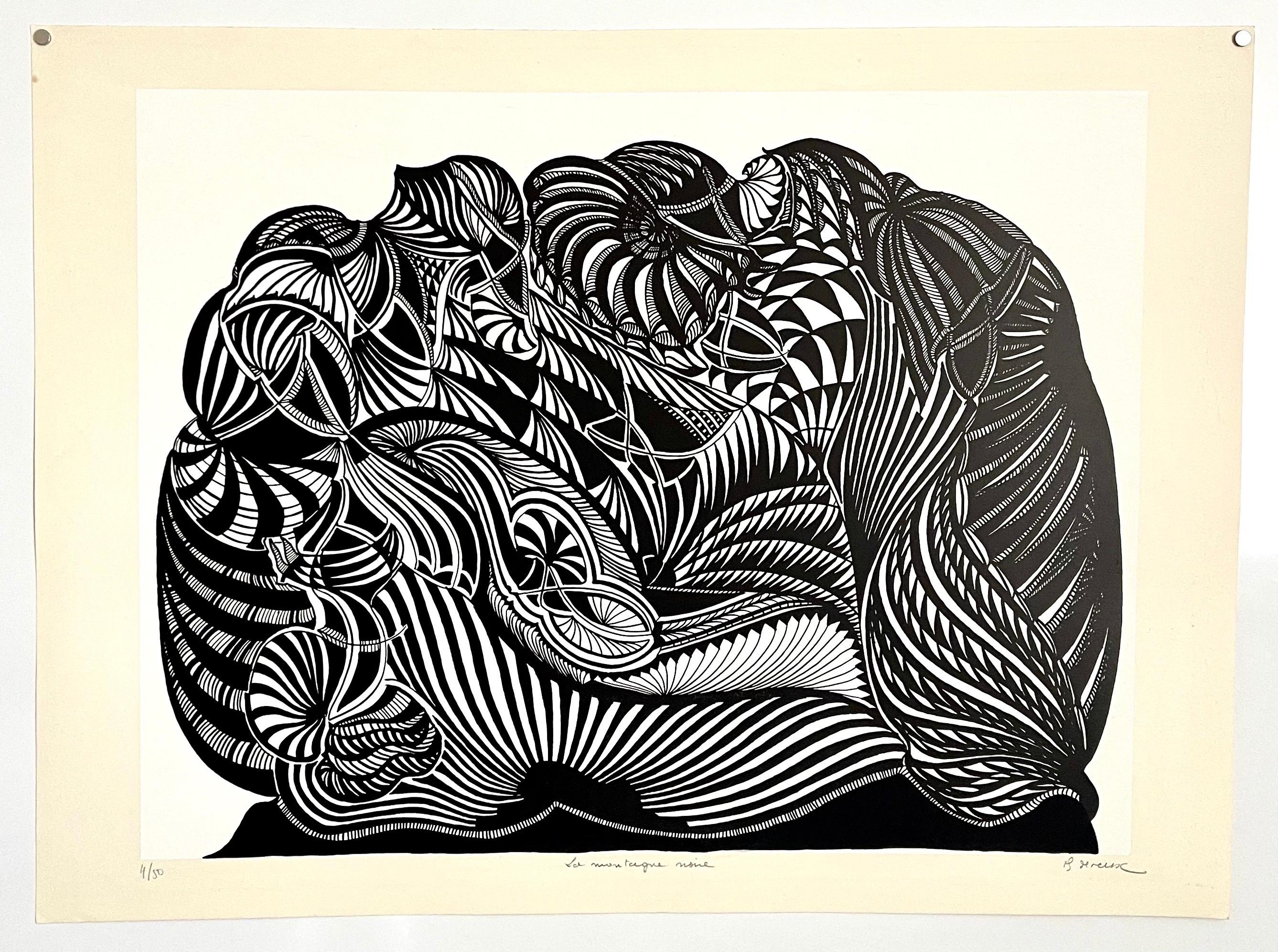Joan Miró “Untitled” (from the Lezard aux Plumes d’Or series)1971
1971
About the Item
- Creator:Joan Miró (1893 - 1983, Catalan)
- Creation Year:1971
- Dimensions:Height: 13.75 in (34.93 cm)Width: 19.75 in (50.17 cm)Depth: 1.5 in (3.81 cm)
- Medium:
- Movement & Style:
- Period:
- Condition:
- Gallery Location:Southampton, NY
- Reference Number:1stDibs: LU14112048832
Joan Miró
With his wide-ranging oeuvre, comprising strikingly original paintings, prints, ceramics, sculptures, metal engravings and murals, Catalan modernist Joan Miró was a critical force in moving 20th-century art toward complete abstraction. Although often considered an early Surrealist because of his nonobjective imagery and evocation of the subconscious, he defies neat categorization.
Miró’s identity is largely rooted in the city of his birth: Barcelona. To this day, a number of his public artworks can be found there, including the 72-foot-tall statue Dona i Ocell (Woman and Bird), 1983. Female and avian forms, along with bright colors and the theme of Catalan pride, are recurring elements in his work.
The radical visual world Miró created with his expressive lines, signature symbols and biomorphic shapes influenced such American Abstract Expressionists as Jackson Pollock and Color Field painters like Mark Rothko and Barnett Newman.
Mirò continued to work and experiment until his death at the age of 90 in 1983. Five years before that, he was quoted saying, “I painted these paintings in a frenzy, with real violence so that people will know that I am alive, that I’m breathing, that I still have a few more places to go. I’m heading in new directions.”
Find a collection of original Joan Miró art on 1stDibs.
- ShippingRetrieving quote...Ships From: Sarasota, FL
- Return PolicyA return for this item may be initiated within 7 days of delivery.
- “Untitled”By Ferdinand SpringerLocated in Southampton, NYOriginal aquatint etching “Untitled” by the Germans artist, Ferdinand Springer. Signed in lower right margin in pencil by the artist and dated 1951. Condition is excellent. Edition size in pencil in lower left margin 98/200. Sheet size (full) is 115 by 22.75. Image size is 9.75 by 18.75. The artwork is housed in a thin antique silver contemporary frame. Overall framed measurements are 19.5 by 27 inches. Under glass. Provenance: A St. Petersburg, Florida collector. Ferdinand Springer, painter and printmaker, was born to a German father and a Swiss mother in Berlin on October 1, 1907. After graduating from high school in Potsdam, he studied art history at the University of Zurich. He began painting in 1927 and visited Milan where he met the Italian painters Giorgio Morandi and Carlo Carrà. Springer moved to Paris in 1928 where he studied with Roger Bissière at the Académie Ranson. In 1932, he learned intaglio techniques at Atelier 17 in Paris and, in 1937, he traveled to New York where he exhibited at the Julian Levy Gallery. During this time he met Alexander Calder and Salvatore Dali...Category
1950s Modern Abstract Prints
MaterialsArchival Paper, Etching, Aquatint
- “Shore Sentry”By Syd SolomonLocated in Southampton, NYShore Sentry, is an original color, limited edition lithograph on handmade German black etching paper; printed by Topaz Editions in 1977. Artist proofs 10. Edition size 100. Provenance:: A Sarasota, Florida collector Signed: Artist signed lower left with edition size Image size: 22 by 30 inches Sheet size: 30 by 38 inches Edition 38/100 Condition: Excellent Overall framed size: 30.25 by 38.25 inches Framed under plexiglass in chrome colored metal gallery frame SYD SOLOMON BIOGRAPHY Written by Dr. Lisa Peters/Berry Campbell Gallery “Here, in simple English, is what Syd Solomon does: He meditates. He connects his hand and paintbrush to the deeper, quieter, more mysterious parts of his mind- and he paints pictures of what he sees and feels down there.” --Kurt Vonnegut Jr. from Palm Sunday, 1981 Syd Solomon was born near Uniontown, Pennsylvania, in 1917. He began painting in high school in Wilkes-Barre, where he was also a star football player. After high school, he worked in advertising and took classes at the Art Institute of Chicago. Before the attack on Pearl Harbor, he joined the war effort and was assigned to the First Camouflage Battalion, the 924th Engineer Aviation Regiment of the US Army. He used his artistic skills to create camouflage instruction manuals utilized throughout the Army. He married Ann Francine Cohen in late 1941. Soon thereafter, in early 1942, the couple moved to Fort Ord in California where he was sent to camouflage the coast to protect it from possible aerial bombings. Sent overseas in 1943, Solomon did aerial reconnaissance over Holland. Solomon was sent to Normandy early in the invasion where his camouflage designs provided protective concealment for the transport of supplies for men who had broken through the enemy line. Solomon was considered one of the best camoufleurs in the Army, receiving among other commendations, five bronze stars. Solomon often remarked that his camouflage experience during World War II influenced his ideas about abstract art. At the end of the War, he attended the École des Beaux-Arts in Paris. Because Solomon suffered frostbite during the Battle of the Bulge, he could not live in cold climates, so he and Annie chose to settle in Sarasota, Florida, after the War. Sarasota was home to the John and Mable Ringling Museum of Art, and soon Solomon became friends with Arthur Everett “Chick” Austin, Jr., the museum’s first Director. In the late 1940s, Solomon experimented with new synthetic media, the precursors to acrylic paints provided to him by chemist Guy Pascal, who was developing them. Victor D’Amico, the first Director of Education for the Museum of Modern Art, recognized Solomon as the first artist to use acrylic paint. His early experimentation with this medium as well as other media put him at the forefront of technical innovations in his generation. He was also one of the first artists to use aerosol sprays and combined them with resists, an innovation influenced by his camouflage experience. Solomon’s work began to be acknowledged nationally in 1952. He was included in American Watercolors, Drawings and Prints at the Metropolitan Museum of Art, New York. From 1952–1962, Solomon’s work was discovered by the cognoscenti of the art world, including the Museum of Modern Art Curators, Dorothy C. Miller and Peter Selz, and the Whitney Museum of American Art’s Director, John I. H. Baur. He had his first solo show in New York at the Associated American Artists Gallery in 1955 with “Chick” Austin, Jr. writing the essay for the exhibition. In the summer of 1955, the Solomons visited East Hampton, New York, for the first time at the invitation of fellow artist David Budd. There, Solomon met and befriended many of the artists of the New York School, including Jackson Pollock, Franz Kline, Willem de Kooning, James Brooks, Alfonso Ossorio, and Conrad Marca-Relli. By 1959, and for the next thirty-five years, the Solomons split the year between Sarasota (in the winter and spring) and the Hamptons (in the summer and fall). In 1959, Solomon began showing regularly in New York City at the Saidenberg Gallery with collector Joseph Hirshhorn buying three paintings from Solomon’s first show. At the same time, his works entered the collections of the Whitney Museum of American Art, the Solomon R. Guggenheim Museum, and the Wadsworth Athenaeum in Hartford, Connecticut, among others. Solomon also began showing at Signa Gallery in East Hampton and at the James David Gallery in Miami run by the renowned art dealer, Dorothy Blau. In 1961, the Guggenheim Museum’s H. H. Arnason bestowed to him the Silvermine Award at the 13th New England Annual. Additionally, Thomas Hess of ARTnews magazine chose Solomon as one of the ten outstanding painters of the year. At the suggestion of Alfred H. Barr, Jr., the Museum of Modern Art’s Director, the John and Mable Ringling Museum in Sarasota began its contemporary collection by purchasing Solomon’s painting, Silent World, 1961. Solomon became influential in the Hamptons and in Florida during the 1960s. In late 1964, he created the Institute of Fine Art at the New College in Sarasota. He is credited with bringing many nationally known artists to Florida to teach, including Larry Rivers, Philip Guston, James Brooks, and Conrad Marca-Relli. Later Jimmy Ernst, John Chamberlain, James Rosenquist, and Robert Rauschenberg settled near Solomon in Florida. In East Hampton, the Solomon home was the epicenter of artists and writers who spent time in the Hamptons, including Alfred Leslie, Jim Dine, Ibram Lassaw, Saul Bellow...Category
1970s Post-Modern Abstract Prints
MaterialsHandmade Paper, Lithograph
- “Venice”By Marc ChagallLocated in Southampton, NYDescription: People have collected autographs of notables for hundreds of years. The desire to have a personal memento from a famous and or important artist drives the collecting field. The top rung of the ladder, in terms of popularity, is a relatively small group of artists called ‘icons’. These are people who’s names and images stay with us, appearing with regularity in our culture. The 20th Century Masters such as Chagall, Picasso, Matisse, Miro, Dali and more recently, Warhol fit this description. The renowned French printer, Fernand Mourlot, printed many of the original posters for the most important artists of the day. In 1959 the studio printed the series Affiches Originales for collectors. They are reduced lithographic versions of the original posters created by the contemporary masters, Picasso, Chagall, Braque, Matisse, Miro, Leger, and Dufy. This announcement was for an Easter exhibition in the city of Vence. This very rare and desirable 1959 Mourlot poster, of which only 1500 were printed and only a handful known to have been signed, has been signed in pencil by the artist, Marc Chagall. The original larger poster...Category
1950s Modern Figurative Prints
MaterialsLithograph, Archival Paper
- “Modele et Sculpeur avec sa Sculpure”By (after) Pablo PicassoLocated in Southampton, NYDescription: Pablo Picasso created the Suite Vollard between 1930 and 1939 in honor of his friend and art dealer, Ambroise Vollard. The suite is comprised of 100 etchings, illustrat...Category
1990s Modern Figurative Prints
MaterialsLithograph, Archival Paper
- “Minotaure Caressant une Femme”By (after) Pablo PicassoLocated in Southampton, NYDescription: Pablo Picasso created the Suite Vollard between 1930 and 1939 in honor of his friend and art dealer, Ambroise Vollard. The suite is comprised of 100 etchings, illustrat...Category
1990s Modern Figurative Prints
MaterialsArchival Paper, Lithograph
- “Judith”By Benton Murdoch SpruanceLocated in Southampton, NYStrong and vibrant color lithograph by the American artist, Benton Murdoch Spruance. Edition size in pencil lower left margin 7/40. Titled in pencil middle margin and signed in penc...Category
1950s Modern Figurative Prints
MaterialsLithograph, Archival Paper
- Trees in Ranchitos II, New Mexico, 1970s Color Lithograph Landscape with TreesBy Andrew Michael DasburgLocated in Denver, CO"Tree in Ranchitos II" (New Mexico) is a lithograph initialed lower right by artist Andrew Michael Dasburg (1887-1979) from 1975. Presented in a custom frame measuring 30 ½ x 36 ¼ inches. Image size is 16 ½ x 23 ¼ inches. About the Artist: Born France, 1887 Died New Mexico, 1979 Andrew Dasburg was born in Paris, but emigrated to New York City in 1892 with his mother. A childhood sickness left him lame, and his artistic propensities were first recognized by a teacher at the crippled children’s school. She enrolled him in the Art Students League in 1902. There he studied under Kenyon Cox, Frank Vincent Dumond, and Birge Harrison. Later, he began taking night classes from Robert Henri at the New York School of Art. Dasburg spent 1908-1910 in Paris, where he was introduced to the great impressionist painters Matisse and Cezanne. Inspired by the work of the European modernists, Dasburg returned to the United States, where he moved to Woodstock, New York. In Woodstock, he and his wife, Grace Mott Johnson, lived with Morgan Russell...Category
1970s American Modern Landscape Prints
MaterialsLithograph, Archival Paper
- Brazilian Contemporary Art by Celia Eid - Questions Sans VueBy Celia EidLocated in Paris, IDFPrint Edition 9, Lithograph on Archival paper Celia Eid is a Brazilian artist born in 1952 who lives and works between Paris, France and São Paulo, Brazil. She graduated from the School of Communication and Arts of the University of São Paulo. She has collaborated with the newspaper O Estado de São Paulo and with several publishing houses: Scipione, Unesp, Edusp. In 1993, she won the Jabuti award for the best cover book and the best graphic project of the year concerning the publishing industry. In 1994 she published the book / comic Penare. After a two-year contract at the Casa Blanca video post-production house, she moved on to digital arts and animation. Based in France since 1997, she works on short pieces of contemporary music, often performed by the Aleph ensemble. Le Rire du Coq by Dominique Clément and Gymel with the soundtrack by Sébastien Béranger, has been presented at several digital art and music festivals around the world. Celia Eid won Best Interactive Film at the Fluxus Internet Film Festival with her animation Silent. Dislocations, created in 2010 with the music of Sébastien Béranger, is a piece for solo piano, electroacoustic music and sculpture. The pianist interacts with the video by throwing a small luminous ball into the sculpture, which triggers a change in the video. Dislocations was broadcast by several video festivals and was also presented live in Paris, São Paulo, Stockton (USA) and Strasbourg. Alongside his personal projects, Eid has led cartoon workshops for young children, in partnership with institutions such as the Forum des Images or Le Cube...Category
2010s Abstract Abstract Prints
MaterialsArchival Paper, Lithograph
- Brazilian Contemporary Art by Celia Eid - Bonnes QuestionsBy Celia EidLocated in Paris, IDFPrint Edition 6, Lithograph on Archival paper Celia Eid is a Brazilian artist born in 1952 who lives and works between Paris, France and São Paulo, Brazil. She graduated from the School of Communication and Arts of the University of São Paulo. She has collaborated with the newspaper O Estado de São Paulo and with several publishing houses: Scipione, Unesp, Edusp. In 1993, she won the Jabuti award for the best cover book and the best graphic project of the year concerning the publishing industry. In 1994 she published the book / comic Penare. After a two-year contract at the Casa Blanca video post-production house, she moved on to digital arts and animation. Based in France since 1997, she works on short pieces of contemporary music, often performed by the Aleph ensemble. Le Rire du Coq by Dominique Clément and Gymel with the soundtrack by Sébastien Béranger, has been presented at several digital art and music festivals around the world. Celia Eid won Best Interactive Film at the Fluxus Internet Film Festival with her animation Silent. Dislocations, created in 2010 with the music of Sébastien Béranger, is a piece for solo piano, electroacoustic music and sculpture. The pianist interacts with the video by throwing a small luminous ball into the sculpture, which triggers a change in the video. Dislocations was broadcast by several video festivals and was also presented live in Paris, São Paulo, Stockton (USA) and Strasbourg. Alongside his personal projects, Eid has led cartoon workshops for young children, in partnership with institutions such as the Forum des Images or Le Cube...Category
2010s Abstract Abstract Prints
MaterialsArchival Paper, Lithograph
- Dario Villalba UNTITLED 5 Limited Conceptualism Spanish Contemporary Grey WomanBy Dario VillalbaLocated in Madrid, MadridDario Villalba - UNTITLED 5 Date of creation: 1975 Medium: Lithograph and photolithograph on paper Edition: 75 Size: 95 x 68 cm Condition: In mint conditions and never framed Observa...Category
1970s Conceptual Abstract Prints
MaterialsArchival Paper, Lithograph
- Large 1960s French Art Brut Lithograph Bold Black & White Op Art Philippe DereuxLocated in Surfside, FLprinted by Pierre Chave, Vence, published by Bianchi Frères in Nice, France ink on watermarked chiffon de Mandeure paper, hand signed in pencil lower right, "PH Dureux," numbered 4/5...Category
1960s Outsider Art Abstract Prints
MaterialsArchival Paper, Lithograph
- Large 1960s French Art Brut Lithograph Bold Black & White Op Art Philippe DereuxLocated in Surfside, FLPrinted by Pierre Chave, Vence, published by Bianchi Frères in Nice, France ink on watermarked chiffon de Mandeure paper, hand signed in pencil lower right, "PH Dureux," numbered 4/5...Category
1960s Outsider Art Abstract Prints
MaterialsArchival Paper, Lithograph






